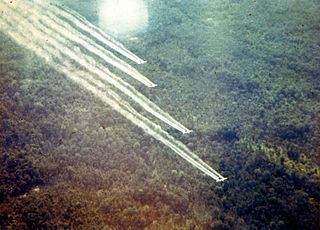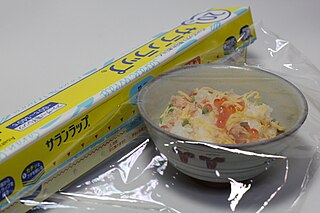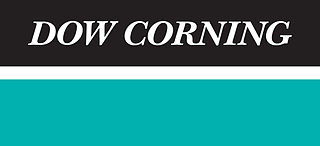Dow, or the acronym DOW, may refer to:

Alexander Theodore Shulgin was an American medicinal chemist, biochemist, organic chemist, pharmacologist, psychopharmacologist, and author. He is credited with introducing MDMA to psychologists in the late 1970s for psychopharmaceutical use and for the discovery, synthesis and personal bioassay of over 230 psychoactive compounds for their psychedelic and entactogenic potential.

Picric acid is an organic compound with the formula (O2N)3C6H2OH. Its IUPAC name is 2,4,6-trinitrophenol (TNP). The name "picric" comes from the Greek πικρός (pikros), meaning "bitter", reflecting its bitter taste. It is one of the most acidic phenols. Like other highly nitrated organic compounds, picric acid is an explosive, hence its primary use. It has also been used in medicine (antiseptic, burn treatments) and dyes.

Styrofoam is a trademarked brand of closed-cell extruded polystyrene foam (XPS), commonly called "Blue Board" manufactured as foam continuous building insulation board used in walls, roofs, and foundations as thermal insulation and water barrier. This material is light blue in color and is owned and manufactured by The Dow Chemical Company.

Operation Ranch Hand was a U.S. military operation during the Vietnam War, lasting from 1962 until 1971. Largely inspired by the British use of 2,4,5-T and 2,4-D during the Malayan Emergency in the 1950s, it was part of the overall herbicidal warfare program during the war called "Operation Trail Dust". Ranch Hand involved spraying an estimated 20 million U.S. gallons (76,000 m3) of defoliants and herbicides over rural areas of South Vietnam in an attempt to deprive the Viet Cong of food and vegetation cover. Areas of Laos and Cambodia were also sprayed to a lesser extent. Nearly 20,000 sorties were flown between 1961 and 1971.

Union Carbide Corporation is a wholly owned subsidiary of Dow Chemical Company. It currently employs more than 2,400 people. Union Carbide produces chemicals and polymers that undergo one or more further conversions by customers before reaching consumers. Some are high-volume commodities and others are specialty products meeting the needs of smaller markets. Markets served include paints and coatings, packaging, wire and cable, household products, personal care, pharmaceuticals, automotive, textiles, agriculture, and oil and gas. The company is a former component of the Dow Jones Industrial Average. Union Carbide was 50.9% stakeholder in Union Carbide India Limited, the company responsible for the Bhopal disaster.

The Dow Chemical Company, commonly referred to as Dow, is an American multinational chemical corporation headquartered in Midland, Michigan, United States, and the predecessor of the merged company DowDuPont. In 2017, prior to the merger, it was the second-largest chemical manufacturer in the world by revenue and the third-largest chemical company in the world by market capitalization. It ranked second in the world by chemical production in 2014.

Herbert Henry Dow was a Canadian-born American chemical industrialist, best known as the founder of the American multinational conglomerate Dow Chemical. He was a graduate of Case School of Applied Science in Cleveland, Ohio. He was a prolific inventor of chemical processes, compounds, and products, and was a successful businessman.

The Dow Event Center is an indoor arena located in Saginaw, Michigan. The center consists of several parts: The Atrium At The Dow Event Center, The Garden Room At The Dow Event Center, The Theater At The Dow Event Center, The Red Room At The Dow Event Center, Huntington Event Park and The Arena At The Dow Event Center. It currently houses the Ontario Hockey League's Saginaw Spirit. The facility has housed a number of hockey teams in the past, such as the Saginaw Lumber Kings and both the IHL and UHL incarnations of the Saginaw Gears.

An agrochemical or agrichemical, a contraction of agricultural chemical, is a chemical product used in agriculture. In most cases, agrichemical refers to pesticides including insecticides, herbicides, fungicides and nematicides. It may also include synthetic fertilizers, hormones and other chemical growth agents, and concentrated stores of raw animal manure.

Rohm and Haas Company is a manufacturer of speciality chemicals for end use markets such as building and construction, electronic devices, packaging, household and personal care products. Headquartered in Philadelphia, the company is organised into three business groups of Specialty Materials, Performance Materials and Electronic Materials, and also has two stand-alone businesses of Powder Coatings and Salt. Formerly a Fortune 500 Company, Rohm and Haas employs more than 17,000 people in 27 countries, with its last sales revenue reported as an independent company at US$8.9 billion. Dow Chemical Company bought Rohm and Haas for $15 billion in 2009.

Saran is a trade name currently owned by S.C. Johnson & Son, Inc. for a polyethylene food wrap. The Saran trade name was once owned by Dow Chemical for polyvinylidene chloride (PVDC), along with other monomers. Since its accidental discovery in 1933, polyvinylidene chloride has been used for a number of commercial and industrial products.

Dow Corning was an American multinational corporation headquartered in Midland, Michigan, United States. Originally established as a joint venture between the Dow Chemical Company and Corning Incorporated, it is now owned by DowDuPont and specializes in silicone and silicon-based technology, and is the largest silicone product producer in the world.
Polyvinylidene chloride (PVDC) is a homopolymer of vinylidene chloride.

1,2-Dibromo-3-chloropropane, (dibromochloropropane) better known as DBCP, is the organic compound with the formula BrCH(CH2Br)(CH2Cl). It is a dense colorless liquid although commercial samples often appear amber or even brown. It is the active ingredient in the nematicide Nemagon, also known as Fumazone.
The Rainbow Herbicides are a group of "tactical use" chemicals used by the United States military in Southeast Asia during the Vietnam War. Success with Project AGILE field tests with herbicides in South Vietnam in 1961 and inspiration by the British use of herbicides and defoliants during the Malayan Emergency in the 1950s led to the formal herbicidal program Trail Dust. Herbicidal warfare is the use of substances primarily designed to destroy the plant-based ecosystem of an agricultural food production and/or to destroy foliage which provides the enemy cover.

Andrew N. Liveris was CEO and chairman of The Dow Chemical Company, a global specialty chemical, advanced materials, agrosciences and plastics company based in Midland, Michigan with 2013 annual sales of more than $57 billion. Liveris has been a member of Dow's board of directors since February 2004, CEO since November 2004 and was elected as chairman of the board effective 1 April 2006. Liveris became CEO in 2004 after holding the position of chief operating officer (COO). Afterwards he served as executive chairman of DowDuPont, where he remains a director. He has been appointed to lead advisory groups to the White House under both the Obama administration and Trump administration.

DowDuPont Inc. is an American company formed after the merger of Dow Chemical and DuPont on August 31, 2017. It is the world's largest chemical company in terms of sales. Within 18 months the company will be split into three publicly-traded companies which will focus on the following: agriculture, materials science, and specialty products. The agriculture division is named Corteva Agriscience, the materials science division is named Dow, and the specialty products division is named DuPont. Jeff Fettig is executive chairman of the company, and Edward Breen is the CEO. The merger has been reported to be worth an estimated $130 billion. DowDuPont ranked No. 47 in the 2018 Fortune 500 list of the largest United States corporations by total revenue.
Dow Chemical Co. v. United States, 476 U.S. 227 (1986), was a United States Supreme Court case decided in 1986 dealing with the right to privacy and advanced technology of aerial surveillance.















